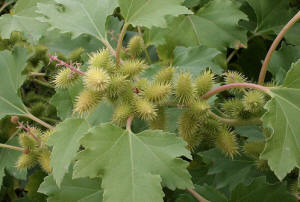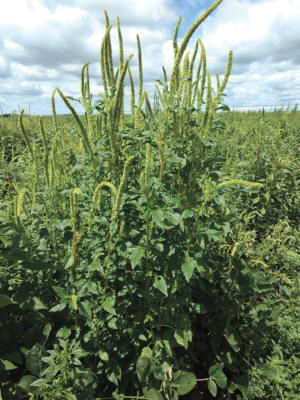|
 The United States
Department of Agriculture’s Forest Service says an invasive plant is
one “whose introduction causes or is likely to cause economic or
environmental harm, or harm to human health.” These plants often
produce many seeds, may have aggressive root systems, and “thrive on
disturbed soil.” The United States
Department of Agriculture’s Forest Service says an invasive plant is
one “whose introduction causes or is likely to cause economic or
environmental harm, or harm to human health.” These plants often
produce many seeds, may have aggressive root systems, and “thrive on
disturbed soil.”
Invasive plants may cause devastation to agriculture by reducing
crop yields and affecting livestock production.
Among the thousands of invasive plants are several that cause issues
around the Central Illinois area and are hard to control.

garlic mustard

kudzu


common waterhemp

giant ragweed

common cocklebur

ivy leaf morning
glory

Troublesome
invasive plants to watch for include garlic mustard, kudzu,
common waterhemp, giant ragweed, common cocklebur,
and ivy leaf morning glory. These invasive plants come in
various shapes and sizes. Traits may include root systems that are
aggressive and may displace native plants and kill vegetation in
addition to decreasing crop yields.

palmer
amaranth
Invasive plant causing problems for many farmers is Palmer Amaranth,
an annual weed which the USDA says “may grow more than three inches
a day eventually reaching more than six feet tall.” This weed
“produces thousands of small viable seeds” which “can remain dormant
in the soils and germinate years later.” Palmer Amaranth can have
multiple negative impacts since it “has the potential to spread to
agricultural fields, can be very difficult to control, can
significantly increase production costs, and may reduce crop yields
due to competition.”
The impact of these invasive plants can be costly. Lisa Schlessinger
and A. Bryan Endres of the University of Illinois said, “It is
estimated that annual costs attributed to invasive plant species in
the U.S. approach $25 billion.” Aside from “costs associated with
harm to agricultural lands,” Schlessinger and Endres also say,
“invasive plant species displace and threaten native plants,
changing the biodiversity and ecology of the state.” Invasive plants
consume nutrients meant for crops, block sunlight, and compete for
space.
According to the U.S. Forest Service, “Invasive plant seeds are
often distributed by birds, wind, or unknowing humans, allowing seed
to move great distances. Some invasives have aggressive root systems
that spread long distances from a single plant.”
If invasive plants are
causing problems, producers need to figure out ways to prevent
spread. In a publication on the management of invasive plants,
Tricia Bethe, Christopher Evans, and Karla Gage say, “The best way
to prevent the spread of invasive plants and pests is to avoid
introducing them.” The article also says you should “not plant or
introduce invasive plants or pests; and eliminate high risk pathways
by not moving firewood.”
[to top of second column] |

Some measures farmers might take to preventing spread from farm to
field include keeping equipment clean and not moving contaminated
gravel, hay or straw. Eradicate weeds along and between fields and
along roadways. While not yet cost effective for most farming, an
alternative weed suppression option includes using a cover crop
during the off-season, between rows before a new crop achieves
canopy and as hedge surrounding active fields.
As seeds can remain viable in the soil for years, you need to find
ways to control invasive plants when you first notice them. Bethe,
Evans and Gage say to be ready to “invest multiple years; control is
never a one-time effort.”

While farming usually focuses on chemical controls for troublesome
weeds, invasives have increasingly become resistant to numerous
chemicals making a multi-layered approach necessary. Today’s
approach calls for assertive combinations of mechanical, chemical,
manual, and cultural means for controlling these plants.
Mechanical control surrounding fields can accomplish some protection
by mowing field edges and ditches a few times year, and by use of
heavy machinery or chainsaws to pull or dig root spreading invasive
plants. In the field during the growing season, row tillage before
crops can provide canopy is utilized.
The USDA remarks that invasive weeds may become such a nuisance that
farmers may need to resort to manual means. Such manual intervention
might include pulling invasive weeds, hoeing and chopping weeds
using labor intensive methods.
A University of Illinois Extension article says: “chainsaws, brush
saws, hedge trimmers, and weed whips create less disturbance than
heavy machinery.” However, equipment must be carefully cleaned
afterwards to prevent spread.
This is a case for following the old cliché, “Nip it in the bud.”
Elimination before the weed sets seed or roots run wild is the best
practice. If done manually, bag any plant with seed before walking
away with it and destroy by fire.
Some producers have introduced their livestock to fields prior to
planting and after harvest, and have had some success turning out
cows, goats and pigs to fields to consume invasives. A word of
caution using this natural cultivator and fertilizer; livestock fed
at the trough may have lost their instinct to forage and not
appreciate the bounty that lies before them.

Cultural control can be done through controlled burning. However, if
not managed or timed properly, the fire could stimulate the growth
of invasive plants like garlic mustard. The U of I Extension says,
“Fire in combination with other methods may be the fastest way to
remove some invasive populations.” If you choose to use controlled
burning, make sure you are complying with the Illinois Prescribed
Burning Act.
The timing for the application of controls is important too. The
University of Illinois Extension Forestry Program invasive plant
management recommends:
• Chemical treatments to annual or biennial plants should be applied
before the plants start flowering.
• Once annual or biennial plants have fruit forming, the most
effective control measure is mechanically removing the plant, making
sure to remove the fruits/seeds from the area. When the fruits start
to mature and fall off of the plant, mechanical treatments should be
halted.
• When fruit mature on some invasive plants, such as garlic mustard,
Japanese stiltgrass, and Japanese chaff flower, care should be taken
to avoid accidentally spreading the seeds of these plants.
• Chemical treatments on woody invasive plants should not be applied
after bud swell/bud break until the plants have reached full leaf
expansion.
• Foliar chemical treatments should be applied to healthy, green,
actively growing foliage. When the foliage starts to turn its fall
color, then foliar treatments are not effective.
Unfortunately, only a small number of invasive plants and noxious
weeds are regulated by the Noxious Weed Act intended to protect
agricultural productivity. Therefore, regulations do not always
address the problem.
An AgWeb article on vigorous weeds and lethargic regulations says,
“Invasive weeds like Palmer Amaranth or other weeds escaping
regulation at the federal or state level have the potential to
devastate agricultural production and native ecosystems.” The
article also says, “Farmers well know that regulation is not the
only answer. But in the face of herbicide resistant weeds such as
Palmer and the growing list of other species, it is important to
explore alternative management practices and the potential for
cooperative arrangements with community stakeholders to protect
their land.”
In public and private partnerships, farmers, landowners and
businesses may need to work together to alleviate problems with
invasive plants and protect land.
Though it may be difficult to completely alleviate the problems
caused by invasive plants, implementing multiple methods for
controlling them can hopefully reduce and minimize their impact to
crops.
Resources
Bethe, Tricia, Christopher Evans, and Karla
Gage. Management of Invasive Plants and Pests of Illinois.
Schlessinger, Lisa and A. Bryan Endres.
“Illinois Invasive Weed Species Cost Farmers and Threaten Native
Plants, 25 June 2016
United States Department of Agriculture Forest
Service. “Invasive Plants.”
Vigorous weeds and lethargic regulations: a
wicked problem. 16 Feb. 2017.
|